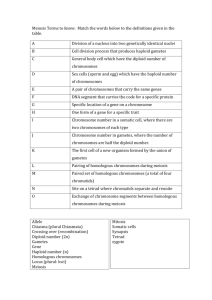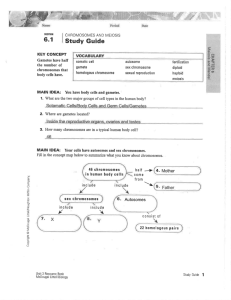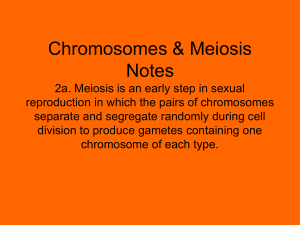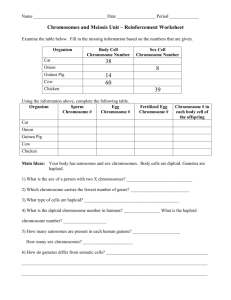Section 6.1: Chromosomes and Meiosis
advertisement
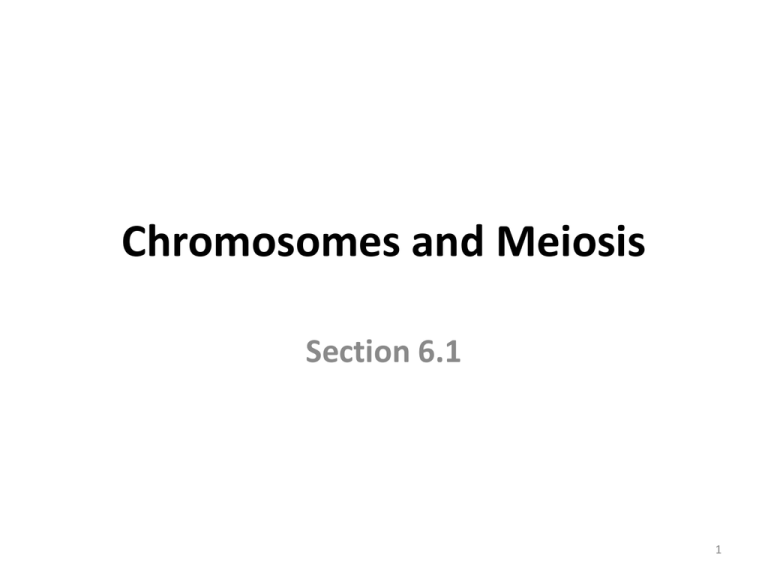
Chromosomes and Meiosis Section 6.1 1 Objectives • SWBAT differentiate between body cells and gametes. • SWBAT compare and contrast autosomes and sex chromosomes. 2 Vocabulary • • • • • • • • • • Somatic cell Gamete Homologous chromosome Autosome Sex chromosome Sexual reproduction Fertilization Diploid Haploid Meiosis 3 Starter • What makes sex cells different from all others? Explain. 4 Somatic Cells and Germ Cells • Your body has two major groups of cells: somatic cells and germ cells. • Somatic cells – are more easily thought of as body cells (they make up your soma – or body). – They make up the vast majority of your cells (ex. spleen, eyeballs, neurons, skin cells, etc.) – DNA in your body cells is not passed on to your children. 5 Somatic Cells and Germ Cells • Germ Cells – are cells in your reproductive organs. – Germ cells are found in the ovaries and the testes and develop into gametes. • Gametes – are sex cells. – They are ova, or eggs, in females. – They are spermatozoa, sperm cells, in males. – DNA in your gametes can be passed on to your children. 6 Human Karyotype What does diploid mean? What does haploid mean? Which chromosomes are autosomes? Which are sex chromosomes? 7 Salmon and Field Mouse Karyotypes Complexity of an organism and number of chromosomes do not seem to be related. Ferns have over 1200 chromosomes. Each species has a characteristic number of chromosomes found in each somatic cell. 8 Homologous Chromosomes You have 23 pairs of chromosomes – 23 from your mother and 23 from your father. Each chromosome pair is referred to as a homologous pair (homologous chromosomes). Homologous chromosomes are two chromosomes that have the same length and general appearance. Genetically, the two chromosomes are not Identical! Most importantly, the two homologous chromosomes have copies of the same genes – though they may be different versions of the same gene. 9 Homologous Chromosomes For example, the gene that codes for Beta Globin is found on chromosome 11. Beta Globin has a recessive allele (form of a gene) that leads to sickle cell anemia. For an individual to have sickle cell anemia, it is necessary for both of the individual’s parents to have given him the recessive, sickle cell causing, alleles (genes) for Beta Globin. 10 Autosomes • Chromosome pairs 1-22 make up your autosomes. – These contain genes for characteristics not directly related to the sex of an organism. – Eye color and blood group are examples of autosomal characteristics. 11 Sex Chromosomes • The 23rd pair of chromosomes are sex chromosomes. – They are XX in female and XY for male mammals. – Birds are different, males are XX (homogametic) and females are XY (heterogametic). – The XY sex chromosomes are not homologous. • The X is significantly larger and carries lots more genes than does the small Y (which carries few genes). Sex Chromosomes 12 Sex Chromosomes • The Y chromosome contains genes that direct the development of the testes and other male traits. – The Y chromosome is the smallest chromosome and contains the fewest genes. • The X chromosome is a large chromosome and contains lots of traits that are unrelated to sexual characteristics (traits absent from the Y chromosome). – This creates sex-linked traits like male pattern baldness 13 Sexual Reproduction • Sexual reproduction involves the fusion of two gametes that results in offspring that are a genetic mixture of both parents. • The actual fusion of an egg and a sperm cell is called fertilization. – When fertilization occurs, the nuclei of the egg and sperm cell fuse to form one nucleus. – The new nucleus must have the correct number of chromosomes for a healthy new organism to develop. 14 Diploid/Haploid Cells • The egg and sperm cell need only half the usual number of chromosomes because they will unite at fertilization – restoring the two pairs of each chromosome. – Body cells (somatic cells) are diploid - meaning a cell has two copies of each chromosome: one copy from the mother, and one copy from the father. • Diploid cells can be represented as 2n. • In humans, the diploid chromosome number is 46 (2*23=46) 15 Diploid/Haploid Cells • Gametes (eggs and sperm) are haploid cells. – Haploid cells - means that a cell has only one copy of each chromosome (22 autosomes and 1 sex chromosome). • Typically, a change in chromosome number is harmful (remember the Down’s Syndrome karyotype) but on occasion it can result in a new species in plants. – For example, there are plants that are 4n (tetraploids), which results in very fast evolution. 16 Diploid/Haploid Haploid Diploid 17 Meiosis • Meiosis is the process that forms gametes from germ cells. – – – – It divides a diploid cell into a haploid cell. It is part of sexual reproduction. It is a form of, like mitosis, nuclear division. DNA is copied once, like in mitosis, but divided twice (only once in mitosis). • Meiosis sometimes called a “reduction division” because it reduces chromosome number by half. – Meiosis makes genetically unique haploid cells from a diploid cell. 18 Meiosis – Differences Between Meiosis and Mitosis 19




